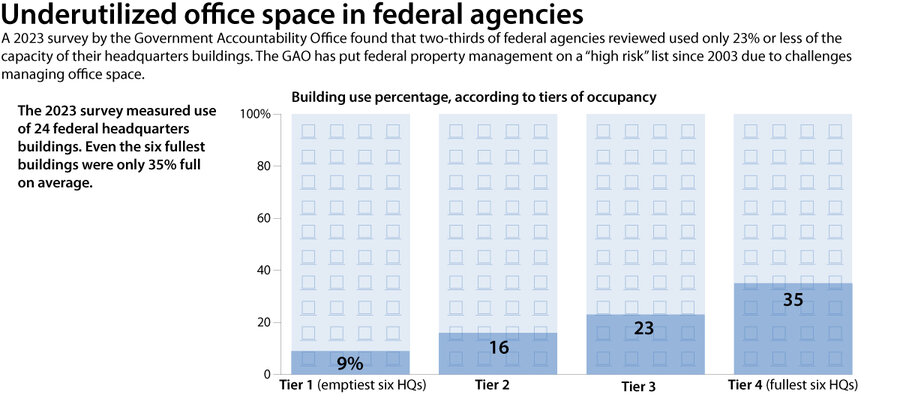The Trump administration’s disruption of the federal workforce features a controversial invitation for workers to voluntarily exit their jobs, but it surely additionally consists of one other provocative element: a name for individuals who keep to get again to the workplace.
On President Donald Trump’s first day in workplace, he issued an government memo ending distant work for federal workers. It was the preliminary transfer in a volley of speedy actions geared toward dramatically pruning the federal payroll.
Some deadlines are actually coming due: On Friday, federal businesses should submit detailed plans to return workers to the workplace in phases, beginning with folks dwelling inside 50 miles from a present company workplace. Many federal staff had additionally been going through a Feb. 6 deadline to determine whether or not to simply accept a promised buyout provide if they didn’t want to return to full-time in-person work. That supply was briefly halted by a federal decide in Boston on Thursday. The White Home stated round 40,000 workers (2% of the federal workforce) had accepted the provide earlier than the decide’s order.
Why We Wrote This
A part of President Trump’s remolding of the federal workforce is an in-person work requirement. Whereas authorities distant work elevated through the pandemic, it was already trending downward.
Trump allies celebrated the return-to-office efforts as a restoration of excessive requirements and authorities accountability. In the meantime, Democrats and plenty of federal workers concern it’s meant to get folks to stop and is a part of a broader assault on the civil service and the experience that comes with it.
However how widespread is it for presidency workers to do business from home? A Trump administration directive to federal staff described telework as “just about unrestricted.” Alternatively, the American Federation of Authorities Staff, a union representing 800,000 federal staff, says that “lawmakers and members of President Trump’s transition staff have spent months exaggerating the variety of federal workers who telework.”
Right here’s a dive into key questions surrounding how distant work truly occurs inside federal businesses, how workplace area is used, and what it could imply for productiveness and morale.
Why is distant and hybrid work beneath fireplace?
Earlier than the COVID-19 pandemic, about 22% of the federal workforce teleworked, that means they generally labored from dwelling or one other authorised website away from their principal workplace on commonly scheduled days. That quantity surged through the pandemic, and has remained nearly double prepandemic ranges.
A parallel shift towards distant work swept the broader financial system – and was seen by many as a menace to employee productiveness. And in Washington, Democratic Mayor Muriel Bowser referred to as for bringing federal staff again to their cubicles to assist the native financial system.
After the election, federal staff got here into the highlight as Elon Musk and Vivek Ramaswamy introduced plans to focus on “unelected bureaucrats” of their new Division of Authorities Effectivity. (Mr. Ramaswamy has since stepped down as a co-head of DOGE.) In December, Sen. Joni Ernst, a Republican from Iowa, launched a 58-page report that accused businesses of permitting federal workplace area to go to waste and failing to meaningfully monitor the productiveness of distant workers. “Within the years since COVID, our nation’s capital has remained a ghost city,” Senator Ernst stated throughout a current listening to.
In January, the primary listening to of the brand new Congress examined federal work insurance policies. Republican members argued that distant work prevents federal staff from acting at peak capability. Democrats contended that distant flexibility not solely improves staff’ high quality of life but in addition permits federal businesses to recruit extra expertise.
Democrats have been swift to color the return-to-office fervor as a technique to demoralize the federal workforce. Messrs. Musk and Ramaswamy wrote final yr that, “Requiring federal workers to return to the workplace 5 days every week would end in a wave of voluntary terminations that we welcome.”
What number of federal workers have versatile work preparations?
As of Could 2024, about half of the federal workforce was working in roles that didn’t permit for telework, in line with the Workplace of Administration and Finances. Ten p.c have been absolutely distant. Others labored in hybrid positions, spending the vast majority of their hours within the workplace.
A Congressional Finances Workplace report analyzing knowledge from 2022 discovered that federal workers teleworked barely much less usually than staff within the personal sector.
“I believe the impression that lots of people have from listening to Trump and his allies is that each single federal worker is working from dwelling on a regular basis proper now, and that’s actually removed from the reality,” says John Marvel, an affiliate professor at American College who research public administration.
Republican lawmakers say the variety of workers working from dwelling remains to be excessive sufficient to be a burden to taxpayers – and never clear.
Authorities businesses don’t have a uniform approach of monitoring and evaluating workers working remotely. And research of the effectiveness of versatile work preparations within the general U.S. workforce are blended: The Society for Human Useful resource Administration cites analysis displaying elevated productiveness and job satisfaction for hybrid staff, as an example, whereas a Stanford paper notes that absolutely distant work is no less than 10% much less productive than in-person work.
Nevertheless, distant work is usually in excessive demand amongst job seekers. That’s vital for recruiters within the federal authorities, the place workers are paid 27% lower than private-sector staff in the identical jobs.
“[Telework] has been an incredible method to recruit and retain federal staff that the federal authorities would by no means be capable to carry on the payroll if these applications weren’t in existence,” says Randy Erwin, nationwide president of the Nationwide Federation of Federal Staff.
What about workplace area?
Many Republicans have cited a 2023 report by the Authorities Accountability Workplace that discovered the vast majority of authorities company headquarters have been utilizing 25% or much less of their workplace area. The report cited elevated distant work as a significant component, though it talked about different longstanding challenges, corresponding to constructing designs that didn’t make sense for a contemporary workforce and lack of funds to renovate.
Regardless of calling staff again to places of work, the Trump administration has additionally reportedly directed the Common Companies Administration to start terminating leases on the 7,500 federal places of work nationwide. The DOGE social media account on X posted final week that the GSA had already ended three leases of “largely empty workplace area” for a financial savings of $1.6 million.
That has raised confusion about the place returning workers will work in the event that they do return to the workplace.
How federal staff are reacting
Mr. Trump’s government order received’t apply to each single employee. Some workers are protected beneath collective bargaining telework contracts, and the order additionally permits businesses to make exemptions they deem essential. However Mr. Erwin thinks exceptions will likely be uncommon.
“We consider that businesses are going to really feel nice stress to carry as many federal staff into the bodily workplace as attainable,” he says.
Staff at some businesses had already signed collective bargaining agreements that locked in present telework ranges by as late as 2029. However an Workplace of Personnel Administration memo on Monday said that company heads have the fitting to find out workers’ stage of in-person work no matter these agreements. In response, the president of the American Federation of Authorities Staff promised to “aggressively defend” worker contracts.
One authorities worker on the Division of Justice, who requested anonymity for concern over job safety, was employed on the situation that distant work could be accessible. He’s a part of a program with extra folks than accessible workplace area, so he and others rotate their time in-person. His superiors don’t but have a transparent plan for the way they’ll match everybody within the workplace.
The worker says working from dwelling has helped staff who can’t afford the excessive price of hire in downtown Washington and will now must face arduous commutes.
“There are different folks within the division who’re typically commuting so far as an hour, two hours every morning from close by cities,” he says. “That impacts your private life.”
One other Division of Justice worker, who equally requested anonymity, works in a division that already returned to the workplace final December to keep away from scrutiny from the Trump administration. The worker says there are some advantages to being in-person.
“It simply feels fuller, and there’s a way of camaraderie being constructed that there in all probability wasn’t earlier than,” he says. However he provides that the pressured return to the workplace feels “punitive,” and says he’s lucky in contrast with others whose lives are extra significantly affected. He doesn’t assume that is actually about the advantages of in-person work.
“The explanation all of those are coming down, and everybody is aware of, is simply purely an attrition technique,” he says. “They’re attempting to get, I believe, as many individuals to resign earlier than they begin doing mass layoffs.”
The manager order probably received’t be the very last thing that makes waves for the federal workforce. Senator Ernst and others have lately launched payments to relocate sure federal headquarters out of the District of Columbia solely.



















